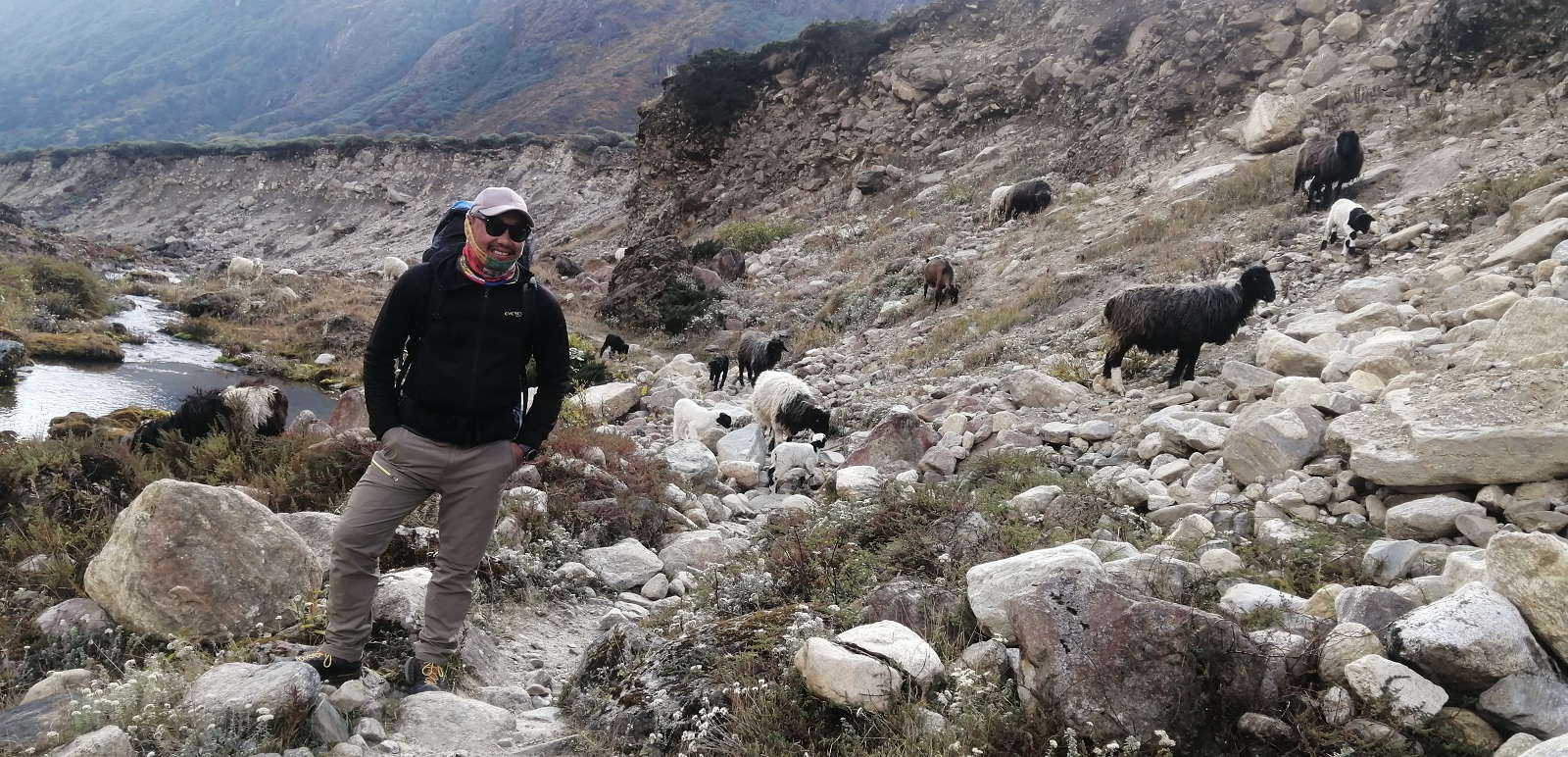Top 5 Trekking Peaks in Nepal
- 2023-08-05
- 0
As categorized by Nepal Mountaineering Association (NMA), the trekking peaks largely fall between 5000m to 7000m. Nepal is home to some of the highest trekking peaks on this planet. As its name implies, climbers can attempt these peaks as part of a normal trekking journey with a bit of extra preparation. However, you will get a distinct permit to scale those peaks with an allied permit fee.
Nepal caters to veteran mountain experts and attracts beginner climbers who want to climb easier, lower-elevated peaks before ascending to the giant massifs. Those should be physically well, in good shape, mentally strong, and psychologically ready to climb those trekking peaks in Nepal. Climbers, even without any prior experience can summit those trekking summits. Still pushing your boundaries, you can try more technical peaks such as Ama Dablam in Nepal.
There are 33 peaks, oscillating from 5,800m to 6,600m, categorized as 'Trekking Peaks' in Nepal by Nepal Mountaineering Association (NMA). While reaching to achieve those peaks, you will enjoy a scenic trek in the foothills of the Himalayan sections, walk past thick backwoods, crossing large rocky lands following the narrow trekking routes.
Nepal is a utopia for travelers, trekkers, explorers, mountaineers, and many other outdoor activities. Among the 13000+ peaks above 6000m, 602 peaks are reachable and allowable for hillwalking by the Government of Nepal and the Department of Tourism. Among them, 414 peaks have had clear routes scaled by climbers of diverse nations at different eras. Still, 188 persist unclimbed but are ready for the climb. Every mountain holds new eagerness and exhilaration.
Scaling the trekking peaks adds a sense of accomplishment and boosts your confidence for climbing high mountain massifs such as Everest, Lhotse, Cho Oyu, Himlung, Manaslu, and so forth. Do you wish to improve your mountaineering skills and want to scale other 7000 to 8000-m peaks in the days to come? If so try summiting trekking peaks at first.
Here is the list of the 5 best trekking peaks in Nepal for climbing.
1. Mera Peak (6,476m/21,247ft)
Mera Peak is one of the easiest, quietest yet the highest trekking peak in Nepal. The reason behind this is despite being the highest trekking peak in Nepal, yet astoundingly easier to achieve. It can be an excellent choice for those who need an introduction to mountaineering.
The journey to Mera Peak commences once landing at Lukla airstrip from Kathmandu via a classic and spectacular mountain flight. From here, we begin our trek to Khare, the last spot before the Mera Base Camp with some teahouses around through the stunning Hinku Valley.
The trekking itself will be sufficient to be prepared for the summit push and it does not need to establish permanent Base Camp amenities for an extended period except practicing using the mountain gears.
Mera Peak’s climbing history is connected with veteran mountain experts such as Sir Edmund Hillary, Eric Shipton, and George Lowe who shaped part of a British expedition that reconnoitered the area in the early 1950s. The first mounting was attained on May 20, 1953, by Col. Jimmy Roberts and Sen Tenzing.
After hiking on the rugged terrains and remote landscapes, Mera La overlooks all three summits of Mera Peak- Mera North, Mera Central, and Mera South. Continuing the journey the trek to Mera High Camp, and on the next day, you will be climbing Mera Peak.
Waking up early morning (let’s say at night around 2 pm), we will start climbing. It is an easy climb, however, you may need to climb gradually as high altitude may add difficulty in climbing. Get heart-stopping views of the mountains from the summit and click pictures before descending. Continue your trek to Lukla using the same route of ascent. A flight back to Kathmandu from Lukla marks the end of an unforgettable Himalayan escapade.
2. Island Peak (6,189m/20,305ft)
Popularly known as Imja Tse, Island Peak is a striking island of ice rocks rang by glaciers along with high massifs. Island Peak was named by the British expedition team members to Everest as it seems like an island in a sea of ice from the village of Dingboche, one of the day destinations for the Everest journey.
Located in the Everest region, Island Peak sits 6,189m/20,305ft above the sea surface. Bask in the beauty of soaring foothills, counting Everest, Ama Dablam, Makalu, Nuptse, Baruntse, Lhotse, and dozen other peaks from the top of Island Peak. This massif is perfect for an introductory climb to high-altitude mountaineering. Also, many climbers climb Island Peak for acclimatizing practices before heading to the higher camps for climbing Everest, Lhotse, etc.
The journey to Island Peak begins with a short scenic flight to Lukla from Kathmandu. Following the general route to Everest Base Camp, we trek to Dingboche, a popular day destination and acclimatization place. However, despite trekking to Lobuche from Dingboche, we will catch the way to Chhukung. Spending a night there undergoing pre-climbing training with our guide in Island Peak Base Camp, we ascend for the summit push.
On the summit push day, we wake up early in the morning and transverse slowly and steadily. This peak is considered as harder than Mera Peak Climbing, and easier than Lobuche Peak for climbing. The vertical climb just before the summit is the hardest part of the entire climb. Savor the breathtaking scenery from the top of the peak before descending back to Base Camp. We then trek back to Lukla via Pangboche and Namche Bazaar before flying back to Kathmandu to end the entire adventure.
Island Peak Climbing follows a forthright course up to the top with only scarce sections which need technical maneuver. Climbers with all levels; novice as well as experienced climbers scale Island Peak. However, the preceding practice of high altitude trek will be a helping hand in your self-assurance.
3. Lobuche East Peak (6,119m/20,070ft)
There are two Lobuche Peaks; Lobuche East and Lobuche West where the first one is the trekking peak and the second one is the expedition peak. Enjoy a Himalayan adventure with Lonuche East Climbing, one of the doable trekking peaks in Nepal with the astonishing sceneries of the dozens of mountain vistas namely Lhotse Face, Pumori, Ama Dablam and notably, a fantastic view of Mt. Everest, which is not visible from Island Peak.
Combining this climb with classic Everest Base Camp Trek offers you both trekking and peak climbing experiences. Appropriate acclimatization is crucial for Lobuche East, and trekking the Everest Base Camp and hiking to Kala Patthar delivers the perfect groundwork to continue on a carefully paced climb of Lobuche East Peak. This peak bids more challenges than its bystanders (Mera Peak, Island Peak), has a more technical feel to it, and is a fitter selection for those who have had some previous mountaineering.
Lobuche Peak Climbing includes some technical ascending and descending with the help of fixed ropes in some sections and travelers need to transverse passing glaciers, snowlands, and icy giants. Mountain nomads must be physically fit, mentally healthy, and psychologically well to climb this peak with some previous alpine walking/climbing experiences. Those who are novice climbers can climb with the assistance of a professional climbing guide with some pre-climbing practices before the actual summit push.
A beautiful journey to Lobuche ease begins with a short, scenic, and thrilling flight to Lukla from Kathmandu. From Lukla, you will be trekking to Lobuche village, one of the most popular day destinations for the classic Everest Base Camp Trek. If your package includes EBC and Kala Patthar, you will continue there but if not, you will head towards Lobuche Base Camp, and High Camp for the summit.
Here, you will attend pre-climb training, and on the following day, you will be summiting the peak. Since technical climbing is involved, you will be using fixed ropes at steeper parts. Savor the grand view of tall mountains, glaciers, and lakes before climbing back. Continue your trek to Namche Bazaar, and Lukla tracked by a flight back to Kathmandu to complete the entire journey.
4. Yala Peak Climbing (5,700m/18,700ft)
Situated at 5550 m above sea level, Yala Peak is a minimal of all the trekking peaks in Nepal. Positioned in the Langtang region of Nepal, the journey to Yala Peak is an exceptional choice for your first Himalayan climb with privileged Tibetan-influenced local culture in the Langtang valley. Along with the magnificent views of Langtang Lirung, Langsisha Ri, Gangchepo, and Dorche Pakpa, it offers great views of Shishapangma (8,013 m) — the highest mountain in Tibet.
A novice trekker without prior climbing experience can climb this peak. However, previous mountaineering experience will be advantageous but is not a requirement. It is the perfect initiation to Himalayan peak climbing; a safe way to have a true mountain experience, even for the very first novices. Part of the trek to this peak also comprises the holy lake of Gosainkunda and passes over the Helambu region which divides the Kathmandu area from Langtang National Park.
With a scenic drive from Kathmandu to Syabrubensi, the gateway of the entire Langtang region, our trekking journey begins. These days we can drive up to Lama Hotel to commence the trek. The trekking journey passes crossing the Bhote Koshi River and walking past a dense forest with rhododendron, bamboo, and oaks to Langtang village.
Trek to Kyangjin Gompa, trailed by a Yala Peak Base Camp hike, where we will be joining prior-climbing exercises with our climbing guide. We will be using different climbing gears including ice axe, crampons, ascenders, karabiners, and others, and practicing rappelling and abseiling skills.
Waking up before dawn and starting climbing Yala Peak slowly and steadily, we will reach the top of the mountain and get breathtaking views of the Himalayan ranges. Retrace your steps back to Syabrubesi via Kyangjin Gompa and Lama Hotel.
5. Pisang Peak (6,091m / 19,978ft)
Pisang Peak Climbing is one of the best trekking peaks in Nepal which is a nearly perfect pyramid of snow and ice. Climbing Pisang Peak sits just opposite Annapurna II (7937) and from the top of it, one can witness Himlung, 7126m, and the trans-Himalayan Tibetan plateau to the north; Manaslu, 8163 m and Khangaru, 6981 m to the northeast; Annapurna II, 7937 m, and IV, 7525 m, Lamjung, 6983 m to the south; Gangapurna,7454 m, Annapurna III, 7555 m, Glacier Dome, 7069 m and Tilicho Peak, 7134 m to the west.
Situated in between the two giants; Annapurna I and Manaslu, both over eight-thousanders, we can reach there through the northern edge of the Manang Valley. Following the classic route to Annapurna Circuit Trek, we hike passing the densely forested lands with rhododendrons and bamboo trees to Dharapani, Chame, and Upper Pisang.
From Upper Pisang, the journey splits and we take the right trekking trail and reach Pisang Peak Base Camp. There, we join pre-climb training, acquire the use of climbing gears, and practice climbing skills like rappelling and belaying with your guide. Wake up early in the morning and gradually ascend on a rocky ridgeline. The summit will reward you with a stunning view of the Annapurna Range, Chulu Range, Manaslu, Damodar Peak, Tilicho Peak, and others. From the summit, we use the same trail back to Chame and drive back to Kathmandu.
By: Krishna Sapkota

